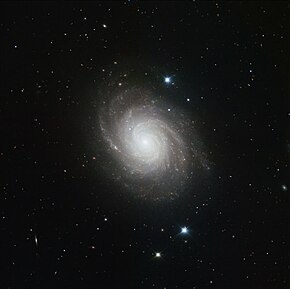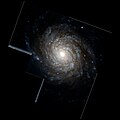| NGC 4030 | |
|---|---|
 | |
| Observation data (J2000 epoch) | |
| Constellation | Virgo |
| Right ascension | 12h 00m 23.643s[2] |
| Declination | –01° 05′ 59.87″[2] |
| Heliocentric radial velocity | 1,465[3] km/s |
| Distance | 63.6 ± 4.9 Mly (19.5 ± 1.5 Mpc)[3] |
| Apparent magnitude (V) | 10.6[4] |
| Characteristics | |
| Type | SA(s)bc[3] |
| Apparent size (V) | 3′.8 × 2′.9[4] |
| Other designations | |
| PGC 37845, UGC 6993[3] | |
NGC 4030 is a grand design spiral galaxy[5] located about 64[3] million light years away in the constellation Virgo. It is a member of the NGC 4030 Group of galaxies, which is a member of the Virgo II Groups, a series of galaxies and galaxy clusters strung out from the southern edge of the Virgo Supercluster.[6] With an apparent visual magnitude of 10.6, it is visible with a small telescope as a 3 arc minute wide feature about 4.75° to the southeast of the star Beta Virginis.[4] It is inclined by an angle of 47.1°[3] to the line of sight from the Earth and is receding at a velocity of 1,465 km/s.[3]
The morphological classification of NGC 4030 in the De Vaucouleurs system is SA(s)bc,[3] which indicates a spiral structure (SA) with no bar (s) and moderate to loosely wound arms (bc).[7] The inner part of the galaxy shows a complex structure with multiple spiral arms, which becomes a symmetric, double arm pattern beyond 49″ from the core.[5] The central bulge is relatively young with an estimated age of two billion years,[8] while the nucleus is inactive.[9]
In 2007, a supernova explosion was discovered in the galaxy from images taken on February 19 from the 1 m Swope telescope at Las Campanas Observatory in Chile. Designated SN 2007aa, it was a type IIP[10] supernova positioned 68″.5 north and 60″.8 east of the galactic nucleus.[11] The progenitor was a red giant star with 8.5–16.5 times the mass of the Sun.[10]
Gallery
[edit]-
NGC 4030 imaged by the Hubble Space Telescope
-
NGC 4030 (SDSS DR14)
References
[edit]- ^ HAWK-I image of NGC 4030, European Southern Observatory, October 27, 2010, retrieved 2013-07-19.
- ^ a b Skrutskie, Michael F.; Cutri, Roc M.; Stiening, Rae; Weinberg, Martin D.; Schneider, Stephen E.; Carpenter, John M.; Beichman, Charles A.; Capps, Richard W.; Chester, Thomas; Elias, Jonathan H.; Huchra, John P.; Liebert, James W.; Lonsdale, Carol J.; Monet, David G.; Price, Stephan; Seitzer, Patrick; Jarrett, Thomas H.; Kirkpatrick, J. Davy; Gizis, John E.; Howard, Elizabeth V.; Evans, Tracey E.; Fowler, John W.; Fullmer, Linda; Hurt, Robert L.; Light, Robert M.; Kopan, Eugene L.; Marsh, Kenneth A.; McCallon, Howard L.; Tam, Robert; Van Dyk, Schuyler D.; Wheelock, Sherry L. (1 February 2006). "The Two Micron All Sky Survey (2MASS)". The Astronomical Journal. 131 (2): 1163–1183. Bibcode:2006AJ....131.1163S. doi:10.1086/498708. ISSN 0004-6256. S2CID 18913331.
- ^ a b c d e f g h Crowther, Paul A. (January 2013), "On the association between core-collapse supernovae and H II regions", Monthly Notices of the Royal Astronomical Society, 428 (3): 1927–1943, arXiv:1210.1126, Bibcode:2013MNRAS.428.1927C, doi:10.1093/mnras/sts145, S2CID 2422011.
- ^ a b c O'Meara, Stephen James (2007), Steve O'Meara's Herschel 400 Observing Guide, Cambridge University Press, p. 133, ISBN 978-0521858939.
- ^ a b Grosbøl, P.; Dottori, H. (June 2012), "Star formation in grand-design, spiral galaxies. Young, massive clusters in the near-infrared", Astronomy & Astrophysics, 542: A39, arXiv:1204.5599, Bibcode:2012A&A...542A..39G, doi:10.1051/0004-6361/201118099, S2CID 54009505.
- ^ "The Virgo III Groups". Atlas of the Universe. Retrieved 2010-11-27.
- ^ Buta, Ronald J.; et al. (2007), Atlas of Galaxies, Cambridge University Press, pp. 13–17, ISBN 978-0521820486.
- ^ Ocvirk, P.; et al. (December 2008), "Extragalactic archeology in integrated light: A test case with NGC 4030", Astronomische Nachrichten, 329 (9–10): 980–983, Bibcode:2008AN....329..980O, doi:10.1002/asna.200811075.
- ^ Hicks, E. K. S.; et al. (May 2013), "Fueling Active Galactic Nuclei. I. How the Global Characteristics of the Central Kiloparsec of Seyferts Differ from Quiescent Galaxies", The Astrophysical Journal, 768 (2): 107, arXiv:1303.4399, Bibcode:2013ApJ...768..107H, doi:10.1088/0004-637X/768/2/107, S2CID 55814012.
- ^ a b Chornock, Ryan; et al. (April 2010), "Large Late-Time Asphericities in Three Type IIP Supernovae", The Astrophysical Journal, 713 (2): 1363–1375, arXiv:0912.2465, Bibcode:2010ApJ...713.1363C, doi:10.1088/0004-637X/713/2/1363, S2CID 119237141.
- ^ Folatelli, G.; et al. (February 2007), "Supernova 2007aa in NGC 4030", Central Bureau Electronic Telegrams, 850: 1, Bibcode:2007CBET..850....1F.
External links
[edit] Media related to NGC 4030 at Wikimedia Commons
Media related to NGC 4030 at Wikimedia Commons


Well, that’s interesting to know that Psilotum nudum are known as whisk ferns. Psilotum nudum is the commoner species of the two. While the P. flaccidum is a rare species and is found in the tropical islands. Both the species are usually epiphytic in habit and grow upon tree ferns. These species may also be terrestrial and grow in humus or in the crevices of the rocks.
View the detailed Guide of Psilotum nudum: Detailed Study Of Psilotum Nudum (Whisk Fern), Classification, Anatomy, Reproduction